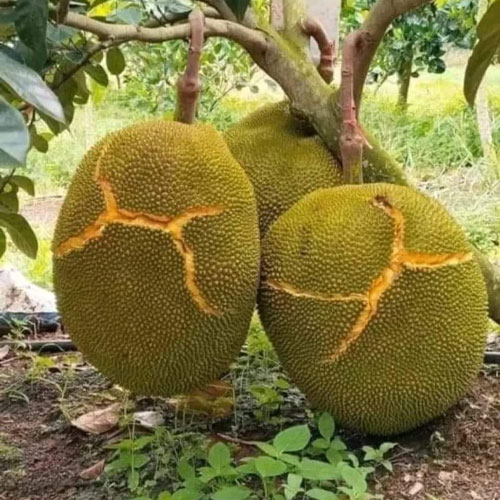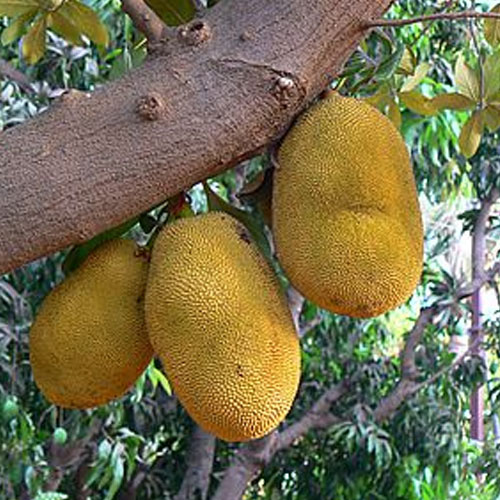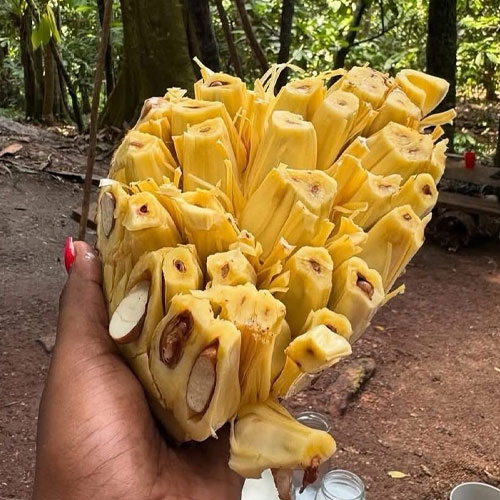The Jackfruit Brazilian Yellow Giant Jack Budded Live Plant is a superior tropical fruit tree variety known for its extra-large fruits ranging from 15 to 40 kg per fruit! This long-living, fast-growing variety from Brazil is prized for its vibrant yellow flesh, rich tropical aroma, and extremely sweet taste. Each fruit is a feast, and the tree is a treasure for gardeners looking to grow large, rewarding, and shade-giving trees.
This budded live jackfruit plant is well-suited for both commercial cultivation and large home gardens. It produces consistently, grows vigorously, and is resistant to many common pests and diseases. With proper care, it can serve you for decades, yielding giant jackfruits year after year.
Variety Name: Brazilian Yellow Giant Jack
Type of Seed/Plant: Budded Live Jackfruit Plant
Germination Time: 15–25 days (for new shoots post-transplant)
Sunlight Requirements: Full Sunlight (6–8 hours daily)
Growing Locations: Home Garden, Farmland, Agroforestry Zones
Growing Season: All year in tropical regions
Seed Sowing Depth: Not applicable (budded live plant)
Ideal Climate: Tropical, humid, warm regions
Plant Height: 1.5 to 2 feet at shipping (mature tree up to 40–50 ft)
Fertilizer Needs: Organic compost, cow dung, NPK monthly
Life Span: 40–60+ years
Ideal Growing Temperature: 25°C to 38°C
Harvesting Time: 3–5 years after planting
Maintenance Required: Moderate
Watering Frequency: 2–3 times/week (more during summer)
Ideal Grow Bag Size: 24x24 inch or direct soil pit



The Brazilian Yellow Giant Jackfruit thrives in warm, humid tropical climates of India. Best planting seasons are March–June and September–November, ensuring strong root development before peak summer or monsoon. Southern and coastal regions are ideal for fast growth and high fruit yields.
While it's a large tree, initial growth can be started in a 24-inch grow bag or drum. Ensure good drainage and rich soil mix. Once the plant outgrows the container (6–12 months), transplant to open ground with proper spacing and sunlight. Water regularly and protect young saplings from heavy wind.
Preparation: Use compost-enriched loamy soil in a pit or grow bag
Planting: Place the budded plant upright with the graft above soil
Watering: Water well after planting and maintain moisture balance
Support: Use bamboo stick support if needed
Growth: New leaves emerge in 10–20 days; sturdy trunk forms in 6 months
Sunlight: 6–8 hours direct sunlight daily
Soil: Well-drained red or loamy soil enriched with compost
Fertilization: Apply organic fertilizer every 30 days
Pruning: Remove dead and crossing branches once a year
Spacing: 20–25 feet between trees for proper canopy spread
Pest Control: Use neem oil spray monthly to control leaf borers
Disease Management: Avoid waterlogging; use Trichoderma if root fungus observed
Mulching: Use dry leaves around base to retain soil moisture
Harvesting: Fruits ready 3–5 years after planting; mature fruit weighs 15–40 kg
1. Apply Nutrient-Rich Fertilizers
When your plants begin flowering, use nutrient-rich fertilizers like Organic Bone Meal Powder or Vermicompost. This helps in boosting the bloom and enhances overall yield.
2. Use Organic Fertilizers
Feed your plants with organic fertilizers such as Cow Dung Manure or Neem Cake. Organic options promote healthy soil life.
3. Regular Feeding
Apply fertilizers every 20-25 days to ensure plants receive a steady supply of nutrients. Choose from various options like Cocopeat Compost for moisture retention.
This Brazilian Giant Jackfruit tree is an outstanding tropical performer. It is budded for early fruiting, meaning faster results than seed-grown trees. It produces enormous fruits that weigh up to 40 kg each, filled with delicious, golden yellow, sweet bulbs. The tree has a strong canopy, acts as a shade tree, and is resilient against climate stress. Its large, leathery leaves and sweet scent attract bees and birds, enhancing biodiversity. This plant is a one-time investment with lifetime rewards!
Grows giant jackfruits with excellent taste and texture
Ideal for organic farming and agroforestry systems
High yield – each tree produces dozens of large fruits
Source of Vitamin C, potassium, and dietary fiber
Used in curries, chips, pickles, sweets, or eaten raw
Generates shade and improves microclimate in gardens
Protect young saplings from heavy winds and cattle
Avoid overwatering; proper drainage is essential
Keep graft union above soil level to prevent rot
Use organic pest control regularly to avoid infestations
Do not prune aggressively during flowering phase
Fruit stalks may require support as fruits grow very heavy
Regular inspection ensures early detection of pests or diseases
Leaf Yellowing: Caused by nutrient deficiency – apply cow dung + micronutrients
Root Rot: Due to waterlogging – improve drainage or repot if in bags
No Flowering: Check sunlight access, add phosphorus-rich fertilizer
Pest Attack: Control with neem oil + soap spray every 15 days
Weak Stem: Provide bamboo support during early stages
Brazilian Jackfruit, Yellow Jack, Giant Jackfruit Plant, Jackfruit Budded Plant, Perakka Chakka, Jacka Tree, Kathal, Chakka, Phanas, Panasa, Halasina Hannu
Q1. When will this tree start producing fruits?
It starts fruiting within 3–5 years if properly cared for.
Q2. How many fruits does a mature tree produce?
A well-maintained tree can produce 30–50 fruits per year, each up to 40 kg.
Q3. Can I grow it in Kerala/Tamil Nadu?
Yes, it's ideal for tropical zones like Kerala, TN, Karnataka, etc.
Q4. Does it need chemical fertilizers?
Not mandatory. Organic compost, cow dung, and neem cake work well.
Sign in now to receive a 5% instant discount on your first order when using code WELCOME. Begin your organic journey today!
By logging in, you're agreeing to our Terms of Service and Privacy Policy.
Gaurav
Golden Hills Farm ke plants genuine aur reliable hote hain.
Eshan
Budded plant ka result abhi se visible hai, growth strong hai.
Rajesh
Fast delivery aur packaging damage free thi, bilkul fresh plant.
Bhavana
Bahut khush hu, ye variety garden me ekdum premium lagti hai.
Himani
Plant lagate hi new shoots aane lage, growth amazing hai.
Sneha
Bahut rare aur unique variety hai, leaves thick aur healthy hain.
Fatima
Healthy aur pest-free plant mila, bilkul expected jaisa.
Chirag
Bahut accha experience Golden Hills Farm ke sath, hamesha quality maintain karte hain.
Aarav
Bahut bada aur lush green plant mila, roots strong aur moist the.
Iqra
Jackfruit Brazilian Yellow Giant Jack Budded Live Plant healthy condition me mila, bahut accha packaging tha.